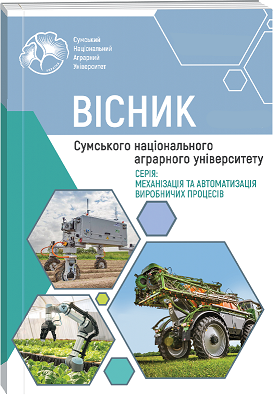TEKRONE COMPOSITE DUMPS ARE AN ALTERNATIVE FOR MODERN AGRICULTURAL MACHINERY
Abstract
Plowing, as one of the types of tillage, aims to meet a number of requirements to ensure the quality of the technological operation and perform its basic functions. Among the tasks set before this operation are: compliance with the specified depth of cultivation and not exceeding the allowable deviation, the formation of the layer should be dense, the cultivated layer of soil should be loose, all available weeds and crop residues should be completely plowed, etc. n. Achieving all the goals is possible only with high-quality selection of units to perform technological operations on certain areas of soil, as well as the choice of working bodies that are variable for agricultural machinery. When considering the plow as a unit for the main tillage, it should be noted that the structural parts of the body, such as dumps, plowshares, field boards, racks have a significant impact on the quality of the process. For example, changing the shape of the dump can significantly affect the process of overturning the treated layer, as well as the prioritization of weeds and crop residues. Increasing the efficiency and reducing the energy consumption of plowing is possible by solving problems to optimize such parameters of the plow as the width of the grip, the geometry and shape of the ploughshare surface of the body. Replacing body or their dumps is a rather long and laborious process, so its implementation, depending on production and meteorological situations, which are often variable, is extremely difficult. However, the time spent on operations to optimize the process of operation of the unit, namely - the replacement of its working bodies with more energy-efficient, durable and able to improve the quality of the technological operation, is justified by the result. This paper presents an analysis of the operation of Tekrone composite dumps, which were installed on a classic plow in order to optimize the operation of the machine-tractor unit. Since this operation does not change the design of the plow, the replacement of the dumps does not require additional intervention to other structural elements. The result of optimizing the plow is to reduce fuel consumption for the plowing process, reduce engine load, the ability to work in higher gear and increase the speed of tillage. At the same time, a significant advantage of composite dumps in comparison with iron ones was revealed – non-sticking of the working surface of the dump when working on wet soils, their quick cleaning, absence of corrosion processes and improved sliding of the treated soil layer on the dump surface. As a result, it can be concluded that Tekrone composite dumps can be an alternative to improve the quality of the plowing process.
References
2. Yanxin Yin, Shuxia Guo, Zhijun Meng, Wuchang Qin, Bin Li, Changhai Luo . (2018). Method and System of Plowing Depth Online Sensing for Reversible Plough. IFAC-PapersOnLine Volume 51, Issue 17, 2018, P. 326-331. https://doi.org/10.1016/j.ifacol.2018.08.199
3. Lobachevsky Y. P., Liskin I. V., Panov A. I., Aldoshin N. V., Plyaka V. I. and Lylin N. A. (2021). Ploughing quality and energy consumption depending on plough bodies type. IOP Conf. Series: Materials Science and Engineering 1030. 012154. doi:10.1088/1757-899X/1030/1/012154
4. Ucgul M., Saunders C. and Fielke J. M. (2017). Discrete element modelling of tillage forces and soil movement of a one-third scale mouldboard plough Biosystems Engineering 155 pp. 44–54.
5. Mazitov N. K., Lobachevsky Y. P., Dmitriev S. Y., Sakhapov R. L., Sharafiev L. Z. and Rakhimov I. R. (2015). Upgraded technology and equipment for soil processing and sowing in extreme conditions Russian Agricultural Sciences 41(1) pp. 75–79.
6. Nuƫescu C., Gageanu I., Cujbescu D. (2021). Theoretical considerations on the optimization of the working process of variable width ploughs. INMATEH - Agricultural Engineering . 2021, Vol. 65 Issue 3, p129-138. 10p. https://doi.org/10.35633/inmateh-65-14
7. Yongjie Ma, Zhiqian Lan, Kaige Zhang, Bangyao Li, Wende Zheng, Yanming Gao, Jianshe Li, Xueyan Zhang. (2021). Effects of Plough Layer Thickness on Soil Nutrients and Cucumber Root Development. Scientia Horticulturae (IF3.463), Pub Date : 2021-08-24, DOI: 10.1016/j.scienta.2021.110498
8. Fenta, H.M.; Hussein, M.A.; Tilahun, S.A.; Nakawuka, P.; Steenhuis, T.S.; Barron, J.; Adie, A.; Blummel, M.; Schmitter, P. (2022). Berken plow and intercropping with pigeon pea ameliorate degraded soils with a hardpan in the Ethiopian Highlands. Geoderma, 407, 115523. https://doi.org/10.1016/j.geoderma.2021.115523
9. Hadi Azimi-Nejadian, Seyed Hossein Karparvarfard, Mojtaba Naderi-Boldaji (2022). Weed seed burial as affected by mouldboard design parameters, ploughing depth and speed: DEM simulations and experimental validation, Biosystems Engineering. DOI: 10.1016/J.BIOSYSTEMSENG.2022.02.005
10. K. Chandra Mouli, S. Arunkumar, B. Satwik, S.BhargavaRam, J.Rushi Tej, A.SaiChaitanya. (2018). Design of Reversible Plough Attachment. Conference: International Conference on Advances in Materials and Manufacturing Applications. 5 (11). https://doi.org/10.1016/j.matpr.2018.10.160
11. Bulgakov, V., Pascuzzi, S., Adamchuk, V., Ivanovs, S., Pylypaka, S. (2019). A theoretical study of the limit path of the movement of a layer of soil along the plough mouldboard. Soil Tillage Res. 195, 104406. https://doi.org/10.1016/j.still.2019.104406
12. Karmakar S. and Kushwaha R. L. (2006). Dynamic modeling of soil–tool interaction: An overview from a fluid flow perspective J. of Terramechanics 43(4) pp. 411–425.
13. Ahmadi I. (2017). A power estimator for an integrated active-passive tillage machine using the laws of classical mechanics Soil and Tillage Research 171 pp. 1–8.
14. Goryachkin V. P. (1973). Collected works in three volumes vol 1 Published for the U.S. Dept. of Agriculture and the National Science Foundation, Wash., D.C. by the Israel Program for Scientific Translations Edition 2d Jerusalem
15. Lin Zhu, Shuang-Shuang Peng, Xi Cheng, Yin-Yin Qi, Jia-Ru Ge, Cheng-Long Yin, Tien-Chien Jen. (2016). Combined finite element and multi-body dynamics analysis of effects of hydraulic cylinder movement on ploughshare of Horizontally Reversible Plough. Soil and Tillage Research, Volume 163, P. 168-175. https://doi.org/10.1016/j.still.2016.06.002
16. Luo, F., Zhu, L., Wei, M., Zhang, J., Zhu, D., & Jen, T.C. (2019). Tillage Condition Effects on Soil/Plow-breast Flow Interaction of a Horizontally Reversible Plow. Procedia Manufacturing. https://doi.org/10.1016/j.promfg.2019.06.045
17. Zhang, J., Yao, H., Chen, L., Zheng, E., Zhu, Y., & Xue, J. (2022). Vibration characteristics analysis and suspension parameter optimization of tractor/implement system with front axle suspension under ploughing operation condition. Journal of Terramechanics. https://doi.org/10.1016/j.jterra.2022.05.001
18. Jia, H., Yu, Z., Zhang, C., Araya, K., Teramoto, C., Liu, F., Zhu, B., Meng, Q., Wang, N., Zhang, M., Wu, Z., Shi, Y., & Li, D. (2013). Three-stage Subsoil Interval Mixing Plough for Improvement of Planosol. Engineering in agriculture, environment and food, 6, 184-190. https://doi.org/10.1016/S1881-8366(13)80007-9
19. Godwin, R.J., O'dogherty, M.J., Saunders, C., & Balafoutis, A.T. (2007). A force prediction model for mouldboard ploughs incorporating the effects of soil characteristic properties, plough geometric factors and ploughing speed. Biosystems Engineering, 97, 117-129. https://doi.org/10.1016/j.biosystemseng.2007.02.001
20. Mishra, T., de Rooij, M., Shisode, M., Hazrati, J., & Schipper, D.J. (2020). A material point method based ploughing model to study the effect of asperity geometry on the ploughing behaviour of an elliptical asperity. Tribology International, 142, 106017. https://doi.org/10.1016/j.triboint.2019.106017

 ISSN
ISSN  ISSN
ISSN 



